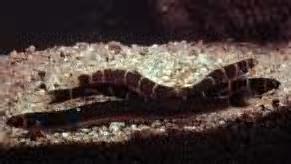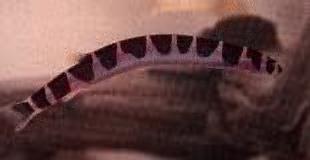Individual Fish Description Page


This page will give a completely detailed profile of the
selected fish, from A to Z. The profiled fish will be
chosen randomly by Badman, and will come from the complete
genre of tropical fish. I will try to up-date the profile
on a monthly basis. If you have a specific fish you want
profiled please vote for it in the favorite fish poll on the main index page.


Acanthophtalmus kuhli kuhli
(Pangio)
Overview:
One of the strangest looking aquarium fish, the Kuhli Loach makes a fine addition to any community set-up.
Quick stats:
| size: | Up to 3 inches |
| tank: | 20 inches |
| strata: | bottom, substrate |
| pH: | 5 to 7 |
| Hardness: | soft to medium |
| temperature: | 79o to 86o f |
Classification:
| Order: | Cypriniformes |
| Sub-order: | Cyprinoidei |
| Family: | Cobitidae |
| Genera: | Acanthophtalmus |
Common name:
Kuhli Loach, Coolie Loach, Leopard Eel, Striped Loach
Distribution:
Java and Sumatra
General Body Form:
Looks much like a worm, with slight lateral compression. Small almost unnoticeable head with small eyes and mouth. the nasal area contains three barbels.

Coloration:
The most noticeable characteristic of the Kuhli are the Fifteen to twenty Brown or Black bands that run from the back down to the belly area. These bands usually split into two on the body sides. The first band runs through the nose, the second through the eyes, the third across the Gill plates and they end at the start of the caudal fin. The background body color is a pale Yellow or Pink
Maintenance:
The Kuhli is Nocturnal by nature and is generally only seen when the tank is dark, therefore it is best kept in a well furnished tank with lots of hiding places. Due to its burrowing habit a soft sandy substrate should be provided. Kuhlis are very fond of Tubifex worms and the freeze dried variety are better to use than the live, due to the trouble they can cause. They will also take all types of flake and frozen food. Often the only time you will see them is when they come out to feed.
Biotope:
These fish are often seen in large masses hiding in plant clumps in the streams of Southeast Asia.
Breeding:
Systematic or planned breeding from what I can found has not yet been achieved, but there are many reports of spontaneous breeding in the home aquarium. It has been said that the pair will closely intertwine at the water surface and scatter the eggs over the area. Females carrying eggs are said to become obese as spawning approaches.



back to the fish profile page.

Email:
badman2nd@hotmail.com






